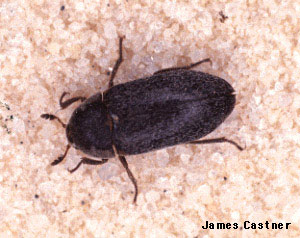
Carpet Beetles
Carpet beetles (Anthrenus spp.)
Carpet Beetles are common and important household pests of fabrics and stored food products. These insects can eat most everything of plant and animal origin including: woolen rugs and clothing, silk clothing, wool carpeting, felts, skins, furs, feathers, upholstered furniture, wool blankets, leather, and dried meats, beans, peas, corn, wheat, rice and many other seeds and seed products. These insects also occur outdoors where they feed in and under dead animals and in the nests of birds, wasps and bees. The larvae or grubs are small, reddish brown and hairy. Larvae develop in dark, undisturbed locations and under normal conditions require about a year to complete their life cycle. Larvae are responsible for all of the feeding damage. Adults emerge in the spring and feed largely on nectar and pollen. Adults commonly congregate at windows in homes.
Carpet beetles are difficult to control because many times it is difficult to locate the origin of the infestation. The best way to combat carpet beetles is to prevent them from becoming established in the home. Rooms should be cleaned often enough to prevent the accumulation of lint, hair and other carpet beetle food materials. These insects are known to build up their numbers in the edges of wall-to-wall carpet; and in wool carpets under heavy furniture that is rarely moved; and in heating system ducts. Another source of carpet beetles is wall voids (the area inside walls between studs) where dead insects accumulate. Abandoned nests of birds, rodents, wasps and bees that are in or near the house may also harbor carpet beetle.
Woolens that have been in storage and undisturbed for over a year should be checked for damage and signs of insects. Dry cleaning or laundering woolens in hot, soapy water will kill carpet beetles. Place cleaned woolens in an insect-free chest or in plastic bags. Do not place mothballs with clothes placed in plastic bags as they may “melt” the plastic and ruin the clothes stored there. Persistent insecticides registered for use inside homes such as Bayer Advanced Home, can be applied in storage areas, edges of carpeting, baseboards, cracks and crevices. Great care should be taken when using this poison in the home. Be sure to read and follow all the instructions and safety precautions found on the pesticide label before using any pesticide.





 Print
Print Email
Email




